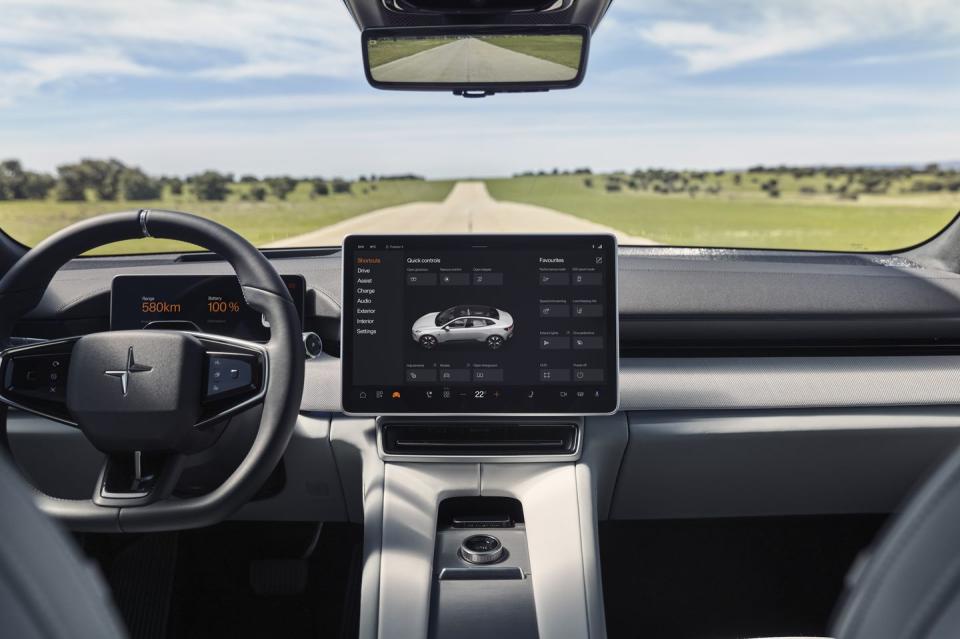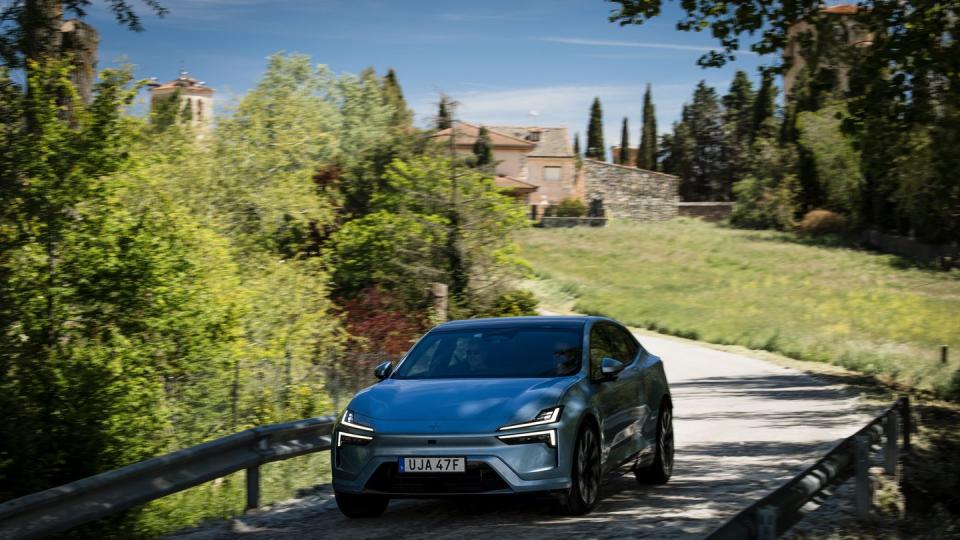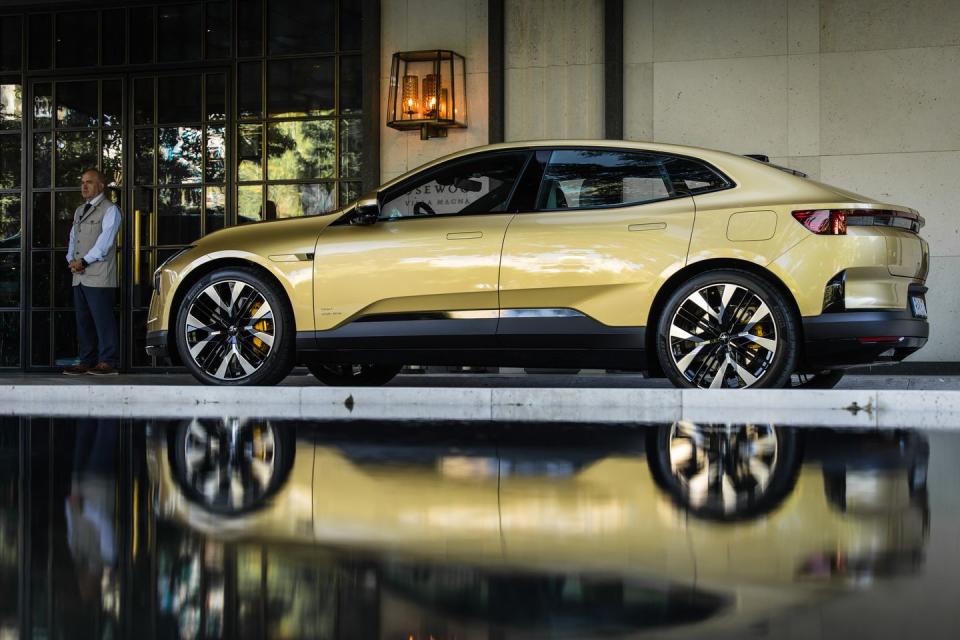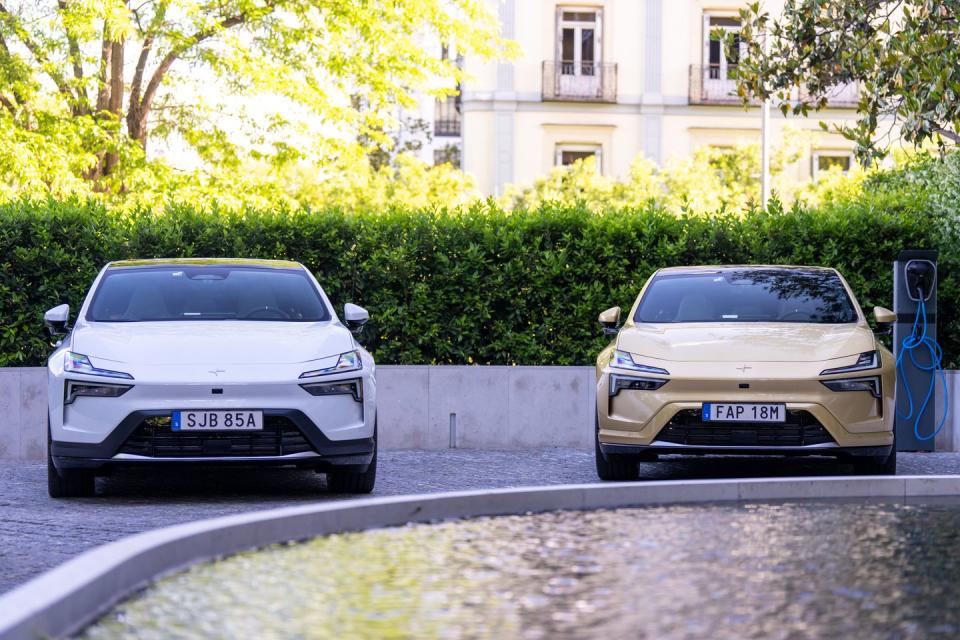Polestar 4 Feels Like an Understudy

The most exciting thing about the Polestar 4 turns out not to be very exciting at all.
This is the car that triggered plenty of online debate when it was unveiled last year without a rear screen, just having solid bodywork from trunk to roof. Despite this, for obscure legal reasons, it does still have a rear-view mirror in the cabin, one that can only show what is happening in the rear seats when working as a mirror. But the rearview also serves as a screen for a camera system with a wide viewpoint to show what is happening behind the car. After five minutes of getting used to the unnatural brightness of the video display, the lack of rear glazing had become a complete non-issue from the driver’s seat.

The problem for Polestar is that the rest of the car doesn’t get a whole lot more exciting. Automakers normally avoid having journalists drive different models on the same event, recognizing the risk of this creating a hero-villain narrative. But because of various delays and other issues outside the company’s control, Road & Track's first drive of the Polestar 4 took place over an identical route in Spain to the one on which I also drove the Polestar 3, the two cars experienced on consecutive days. And on the roads over which the Polestar 3 felt great, the Polestar 4 generally didn’t.

Despite their shared branding, all-electric powertrains, and similarly futuristic design, the Polestar 3 and Polestar 4 are more cousins than siblings. The Polestar 3 sits on Volvo’s SPA2 architecture, which will also underpin the forthcoming Volvo EX90. The Polestar 4 sits on the cheaper Geely Group SEA platform, one used by various Chinese market models and also the compact Volvo EX30. The entry-level rear-drive Polestar 4 will be $56,300, while the fully loaded AWD version with the Plus and Performance packs is $74,300—just $500 less than the most basic AWD Polestar 3.
On performance, the hierarchy is reversed. The dual-motor AWD Polestar 4 produces a system peak of 536 hp—26 hp more than the Performance Pack Polestar 3—and on the company’s figures, its 3.7-second 0-60 mph time is 0.8 seconds quicker than the most potent Polestar 3. The Polestar 4’s 100-kWh battery pack has fractionally less capacity, although it's still sizeable by segment standards, but predicted EPA range figures of the two cars are almost a wash, with the 4 AWD’s 270 miles nearly identical to the 279 miles of the Polestar 3 Performance. The only area where the Polestar 4 is noticeably adrift is on charging speed, supporting a maximum rate of 200 kW on DC, versus 250 kW for the Polestar 3.
But with length, width, and wheelbase similarly close—the biggest dimensional difference is the Polestar 4’s 3.7-inch lower height thanks to its coupe-like roofline—the obvious conclusion is that Polestar has used different sets of ingredients to create two very similar cars. Which isn’t how the auto industry normally works.

Not that the Polestar 3 has everything its own way in a direct comparison. Parked next to each other the Polestar 4 is definitely the more striking-looking car. It is lower and sleeker than its SUV sibling but still has decent legroom for rear-seat occupants. There’s something strongly reminiscent of another handsome, futuristic EV in the Polestar’s glasshouse and cab-forward stance - it could almost be a slightly stretched, coupe version of the Jaguar iPace. The lack of a rear screen does make the Polestar look a little strange and alien at the rear, but in a cool way – and the lower bonnet line gives a more distinctive front-end graphic than the Polestar 3’s relative abundance of empty space.
The Polestar 4’s cabin keeps with the company’s minimalist aesthetic—conventional switchgear culled to the point of near-extinction and with most interaction through the 15.4-inch landscape central touchscreen. The big display looked great, but struggled to deliver on actual touch sensitivity, the two cars I drove in Spain often failing to detect my fingers. The Android Automotive UX still feels clunky and overly complex especially given the number of functions that need to be controlled through it. The steering column, door mirrors, and—as in some Porsche models—even the position of the dashboard air vents needs to be adjusted through the screen. It makes everything feel harder than it should, especially when almost every input has to be made multiple times.
These are niggles compared to the bigger issues with the driving experience, and the contrast with the much classier Polestar 3. The Polestar 4 feels less substantial, both in terms of refinement but the inconsistency of many dynamic details. Accelerator response in the AWD version I drove first was non-linear, and often suffered from a response delay after a period of constant speed cruising. Steering is direct and quick-acting, but with springy assistance and a disappointing lack of feedback—something the Polestar 3 has an impressive amount of. Grip levels in the 4 felt initially keen, but it was easy to push beyond these into soggy understeer. Noise levels were high for an EV, too—with tire roar and suspension noise joined with wind whistle from the front pillars above 75 mph.

Much of the above criticism has probably been sharpened by the contrast with the much more solid-feeling Polestar 3. But in one area the Polestar 4 slips into objective badness; ride quality. The AWD version I drove first had variable adaptive dampers working with steel springs. But, regardless of which of the three settings these were in, they were unable to deliver comfort over rougher roads, where the car picked up an uncomfortable level of motion on high-frequency bumps. It was better at lower speeds, but still lumpier than something with so much of its mass in an underfloor battery pack should feel.
The Twin Motor has an abundance of pace—even if the chassis gives limited encouragement to fully unleash it—with acceleration staying strong even as what will be the highest speed limit in most parts of the world comes and goes. Switching to the single-motor rear-wheel drive version halves the total power output, and nearly doubles the 0-60mph time to 6.9 seconds, but also proves that 272 hp is still more than enough to deliver swift progress in a car with instant torque and no gear changes. The Single Motor version is also lighter, although its 5140-lb curb weight is only 150 lbs less than the Twin Motor on Polestar’s numbers, handling and responses feel unchanged. As, sadly, does the jagged ride on what are now passive dampers. The Single Motor also gets an increase in range, up to an EPA-predicted 300 miles.

The cheapest version of the Polestar 4 is definitely where it makes the most sense given an entry point only $5000 higher than the basic Polestar 2. But at the other end of the range, this is a car that feels compromised and obviously overshadowed by a more talented rival. A rival that happens to be another Polestar product.
You Might Also Like

 Yahoo Finance
Yahoo Finance 